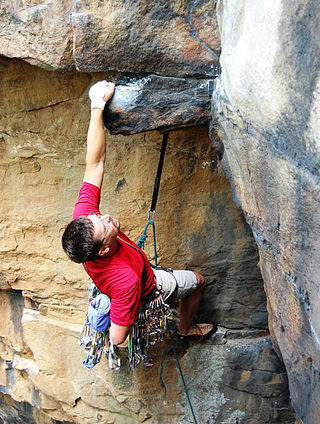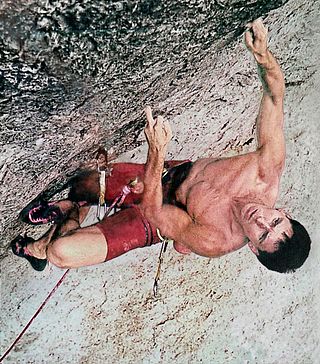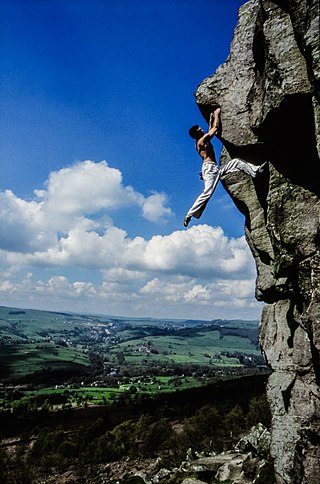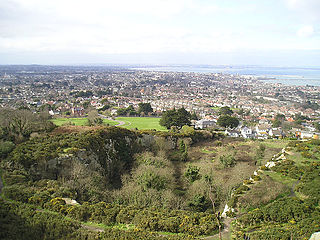Related Research Articles

Many climbing routes have a grade that reflects the technical difficulty—and in some cases the risks and commitment level—of the route. The first ascensionist can suggest a grade, but it will be amended to reflect the consensus view of subsequent ascents. While many countries with a strong tradition of climbing developed grading systems, a small number of grading systems have become internationally dominant for each type of climbing, which has contributed to the standardization of grades worldwide. Over the years, grades have consistently risen in all forms of climbing, helped by improvements in climbing technique and equipment.

Traditional climbing is a type of free climbing in rock climbing where the lead climber places the protection equipment while ascending the route; when the lead climber has completed the route, the second climber then removes the protection equipment as they climb the route. Traditional climbing differs from sport climbing where the protection equipment is already pre-drilled into the rock in the form of bolts.
Ben Moon is a rock climber from England. During the late 1980s and early 1990s, Moon, along with climbing partner Jerry Moffatt, were the two strongest British rock climbers and were key pioneers in the development of standards in international sport climbing. In 1991, Moon made the first-ever redpoint in history of a consensus grade 8c+ (5.14c) climbing route with his ascent of Hubble.

Fair Head or Benmore is a 5-kilometre (3.1 mi) long, 200-metre (660 ft) high, mountain cliff, close to the sea, at the north-eastern corner of County Antrim, Northern Ireland. The cliff's sheer and vertical 100-metre (330 ft) high dolerite rock face is shaped into distinctive vertical columns like organ pipes, which formed 60 million years ago when a sill of igneous rock was injected between horizontal Carboniferous sediments.

Johnny Dawes is a British rock climber and author, known for his dynamic climbing style and bold traditional climbing routes. This included the first ascent of Indian Face, the first-ever route at the E9-grade. His influence on British climbing was at its peak in the mid to late-1980s.
Steve McClure is a British rock climber and climbing author, who is widely regarded as Britain's leading and most important sport climber for a period that extends for over two decades, starting from the late 1990s. In 2017, he created Rainman, Britain's first-ever 9b (5.15b) sport route, and by that stage was responsible for developing the majority of routes graded 9a (5.14d) and above in Britain. Although mainly known for sport climbing, McClure has also been one of the most successful British traditional climbers, and British onsight climbers.

Wolfgang Güllich was a German rock climber, who is considered one of the greatest and most influential climbers in the history of the sport. Güllich dominated sport climbing after his 1984 ascent of Kanal im Rücken, the world's first-ever redpoint of an 8b (5.13d) route. He continued to set more "new hardest grade" breakthroughs than any other climber in sport climbing history, with Punks in the Gym in 1985, the world's first-ever 8b+ (5.14a), Wallstreet in 1987, the world's first-ever 8c (5.14b), and with Action Directe in 1991, the world's first-ever 9a (5.14d).

Jerry Moffatt, is a British rock climber and climbing author who is widely considered as being the best British rock climber from the early-1980s to the early-1990s, and was arguably the best rock climber in the world in the mid-1980s, and an important climber in the history of the sport.

Master's Edge is an 18-metre (59 ft) gritstone arête that is a rock climbing route in the "Corners Area" of Millstone Edge quarry, in the Peak District, England. When English climber Ron Fawcett completed the first free ascent of the route on 29 December 1983, it was graded E7 6c, and one of the hardest traditional climbing routes in the world; it remains one of the hardest gritstone climbs.

In the history of rock climbing, the three main sub-disciplines—bouldering, single-pitch climbing, and big wall climbing—can trace their origins to late 19th-century Europe. Bouldering started in Fontainebleau, and was advanced by Pierre Allain in the 1930s, and John Gill in the 1950s. Big wall climbing started in the Dolomites, and was spread across the Alps in the 1930s by climbers such as Emilio Comici and Riccardo Cassin, and in the 1950s by Walter Bonatti, before reaching Yosemite where it was led in the 1950s to 1970s by climbers such as Royal Robbins. Single-pitch climbing started pre-1900 in both the Lake District and in Saxony, and by the late-1970s had spread widely with climbers such as Ron Fawcett (Britain), Bernd Arnold (Germany), Patrick Berhault (France), Ron Kauk and John Bachar (USA).

Dalkey Quarry is a long-disused 19th century granite quarry located on Dalkey Hill in the Dublin suburb of Dalkey, which was used to build several large maritime structures in south Dublin. Since passing into public ownership in the early 20th century and becoming part of Killiney Hill Park, it has become one of the most important rock climbing venues in Ireland, with over 350 graded routes, some of which are amongst the hardest single-pitch rock climbs in the country such as Indecent Assault. The climbs are all traditional climbing routes and no bolted sport climbing routes are permitted, although some metal pegs are tolerated on the most extreme routes.

Ailladie, is an 800-metre-long (2,600 ft) west-facing limestone sea cliff, that varies in height from 8 metres (26 ft) to 35 metres (115 ft), situated on the coast of The Burren in County Clare, Ireland. Ailladie is one of Ireland's most highly regarded rock-climbing locations, particularly for high technical grade single pitch traditional climbing routes and deep-water soloing routes. It is also a location for shore-angling competitions, and, with its cliffs and view of the Aran Islands, is a popular photography stop for tourists.
Michael Fowler is a British rock climber, ice climber, mountaineer and climbing author. He is internationally noted for his alpine climbing, and was awarded the Piolet d'Or three times, with Paul Ramsden, in 2003, 2013, and 2016, for alpine-style first ascents of faces in the Himalayas. Fowler was one of the first British rock climbers to free an E6-graded traditional rock climbing route, and the first ice climber to free a consensus grade VI mixed climbing Scottish winter route.
Harold Drasdo was an English rock climber, writer and educationalist.
Peter Reginald James Harding was a British rock climber who was prominent in the development of traditional climbing in Britain during the period following World War II.

Dinas Cromlech or Dinas y Gromlech is a distinctive rhyolite rock outcrop at the Llanberis Pass, in Snowdonia, northwest Wales, which has a distinctive "open book" shape that is clearly visible from the road (A4086), and is very popular location for rock climbers and contains some of Britain's most famous and notable rock climbing routes, several of which are important in the history of rock climbing.
Ron Fawcett is a British rock climber and rock climbing author who is credited with pushing the technical standards of British rock climbing in traditional, sport, bouldering and free soloing disciplines, in the decade from the mid-1970s to the mid-1980s, and of pioneering the career of being a full-time professional rock climber. At the end of the 1970s to the early 1980s, Fawcett was widely considered the best and most notable rock climber in Britain.

Philip "Jimmy" Jewell was a British rock climber and free soloist who was active during the 1970s and 1980s.
Robert Andrew Pollitt was a British rock climber who was one of the most prominent traditional climbers and sport climbers of the late 1980s and early 1990s. In 1992, after having successfully repeated Punks in the Gym in Australia, the world's first-ever 8b+ (5.14a) graded sport climbing routes, he quit climbing and permanently emigrated to Australia. In 2016, Pollitt published an autobiography, titled Punk in the Gym. He died from a cerebral aneurysm on 13 November 2019.
References
- 1 2 3 4 5 6 7 8 9 10 11 12 13 Venebles, Stephen (17 March 1998). "Obituary: Peter Livesey" . The Independent . Archived from the original on 25 May 2022. Retrieved 6 January 2022.
- 1 2 3 4 5 6 Ward, Mick (14 January 2021). "The Stone Children - Cutting Edge Climbing in the 1970s Feature". UKClimbing. Retrieved 6 January 2022.
- 1 2 3 Sheard, John; Radtke, Mark (March 2014). Pete Livesey - Fast and Free: Stories of a Rock-Climbing Legend. 2QT. ISBN 978-1910077016.